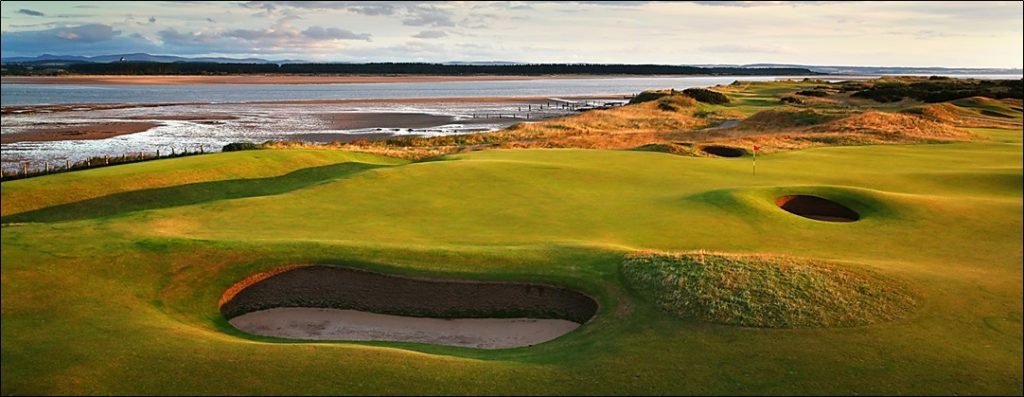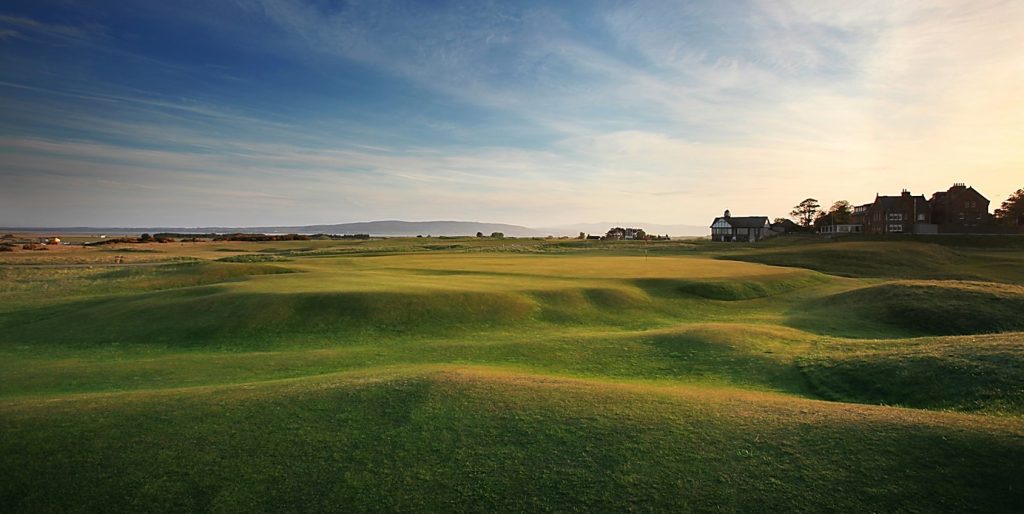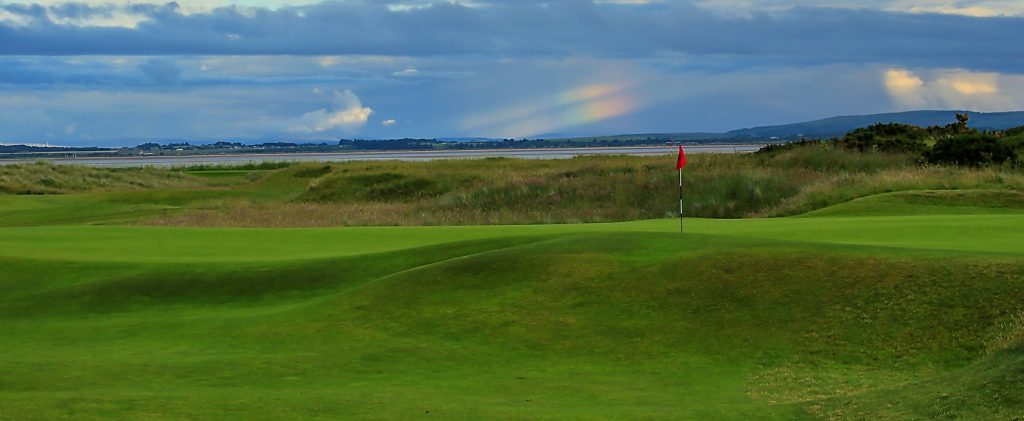
So you have a seven day golf vacation, and you’ve determined that the St Andrews Old Course is a ‘must play’. This isn’t an unusual start position, and naturally you think that staying in St Andrews is the sensible thing to do as well. Again, this is quite logical too. St Andrews might be an expensive location, but it oozes golf. Your experience needn’t be limited to your golf though. St Andrews also has a certain charm to it being a legitimate visitor attraction regardless of its golf. If you’re playing through the ballot however, we can’t know what precise day we’ll peg it up on the Old Course, but we can make an allowance. Instead we can set a day aside safe in the knowledge that our St Andrews base allows us the flexibility to respond to any ballot at 48 hours and re-arrange other rounds onto this shifting spare day. It isn’t long then before we turn to the question of how to fill the rest of an itinerary, and this sets up the search for golf courses near St Andrews in the wider Kingdom of Fife, and how you might best strike the balance between the two so as achieve the best result After the Old Course, the next step that visiting golfers will normally make is the marque names in the surrounding area and add these. Carnoustie as an Open Championship venue and with a world ranking in the high 20’s is the first on the list, quickly followed by Kingsbarns which also holds a ranking that puts it in the top-75. Of the two, Carnoustie is the most difficult to rearrange in the event of a round clashing with the Old Course ballot. It makes sense therefore to slip Carnoustie onto the one day of the week where a clash can’t happen, Sunday. Kingsbarns is the most expensive round of the week and not one you’d wish to put at risk of forfeit should it too clash with an Old Course ballot. The best way of handling Kingsbarns therefore is to check whether the Old Course has any block-out in your week concerned and if it does, to shadow this with a round at Kingsbarns, or if it doesn’t, to play it early so as to provide the maximum numbers of days elsewhere the week in the week to execute a re-arrangement and minimise the risk of a forfeit. By this stage we’ve inked in three days and have four left, and its typically at this juncture that your thoughts to turn trying to referee between St Andrews versus Fife. Do you focus on St Andrews or do you expand your horizons to the golf courses near St Andrews by venturing along the coastline picking up the ancient old links of Fife? In terms of convenience, the courses of the St Andrews Links Trust are on your doorstep and they’re the easiest to begin ticking off. With the exception of the Castle Course however, they all play in more or less the same piece of land. Sure, the course designs provide variety of sorts, but its the subtle type. They can perhaps never quite have the different challenges and personality that you’ll get from playing distinctly different courses on different terrain. It’s perhaps worth checking with worldtop100golfcourse.com and seeing if they can arbitrate by way of their Scottish rankings 22 – St Andrews Castle Course 26 – St Andrews New Course 27 – St Andrews Castle Course 31 – Lundin Links 33 – St Andrews Dukes Course 35 – Elie 47 – St Andrews Jubilee Course 48 – Leven Links 53 – Scotscraig 57 – St Andrews Torrance 67 – Crail Balcomie 70 – Crail Craighead 72 – St Andrews Kittocks 79 – St Andrews Eden Course Whereas such rankings are only ever indicative there is broad pattern of the higher ranked, quality courses being in St Andrews, the greater variety in Fife, and then the lowest quality being back in St Andrews. It’s never easy to determine how much of these rankings are corrupted slightly however by reviewers ‘playing’ the name of St Andrews? So let us now turn to how we might fill our remaining four days The St Andrews New Course is a present-pay-and-play proposition on Saturdays. Visitors can’t pre-book it. The Links Trust only release half the tee-times for Saturday on the day of play. It might sound ad-hoc, but it works surprisingly well. For the visiting golfer it means we can make low-risk ballot applications to play the Old Course for Saturdays safe in the knowledge that should we succeed, then we haven’t got to worry about re-arranging a cancelled tee-time or potentially forfeiting a green fee if we can’t. If you were so minded to play a double-day, you could always tag the Eden Course into the late afternoon. The Dukes Course isn’t a links. It’s a heathland course with some linksy characteristics. It’s owned and managed by the Old Course hotel and is about three miles inland. It can normally be played on a later arrangement too if you preferred to use it accordingly. We keep hearing so many good things from those of you who play the Castle Course that perhaps we have to include it as a dedicated day now. The Castle is a cliff-top course and easily the most aesthetic of the St Andrews tracks. It’s hilly and demanding though. It needn’t be one which you’d want to double-up. The two other cliff-top courses are the Torrance and the Kittocks. These are owned by the Fairmont hotel and often come packaged up in any stay and play arrangements. Of the three cliff-top courses however, then we’d probably advise Castle, Torrance, and Kittocks, in that order This now means we have five days accounted for and another two to allocate. At this juncture Faraway Fairways would be of the view that you break away from the ‘auld grey toon’, and look instead to golf courses near St Andrews, in Fife. The links of Fife are amongst some of the oldest in golf. They’re typically shorter than the modern courses, and you can consider some double-days on them as a consequence. Lundin and Leven are separated by a matter of just three miles. They’re obvious candidates. The two courses at Crail are another one and perhaps a little bit perplexing. The ranking has been a bit harsh on Crail you feel, the historic Balcomie links in particular. At about 5500 yds this is a course that does seem to divide opinion. Its supporters love it for its quirky lay-out of hanging lies and shots played from elevated tees, over secluded coves around curved bays etc. There are those however who also point to the comparative weakness of the inland section. Both opinions are legitimate. We might of course turn our attention to the other two courses in Fife that currently hold higher rankings. In truth though, as fun as Elie can be, it’s difficult to perhaps justify dedicating an entire to unless you were perhaps looking to take it a bit easier. You could perhaps consider dovetailing one of the Crail courses with Elie however. They might not be perfect neighbours, but at 12 miles or 30 minutes apart they’re hardly long-distance relatives either Scotscraig probably falls into the same description as Elie, although you could consider tagging it in as an evening round on the way back from a morning round at Carnoustie Perhaps there’s another answer emerging though for those of you who feel Crail might leave you a fraction underwhelmed? In 2020 Scotland’s newest links opens on the Largo coast at Dumbarnie. The pre-opening PR and the green fee suggests that they’re seeking to establish a status similar to that enjoyed by Kingsbarns or Castle Stuart. Even if they fail to nail down a prestigious world top-100 slot (and it’s increasingly competitive) we can perhaps already see that they’ll have built something that is comparable to Dundonald, which is going to mean that it can justify it’s own dedicated day without any loss of integrity
Error: Contact form not found.

















